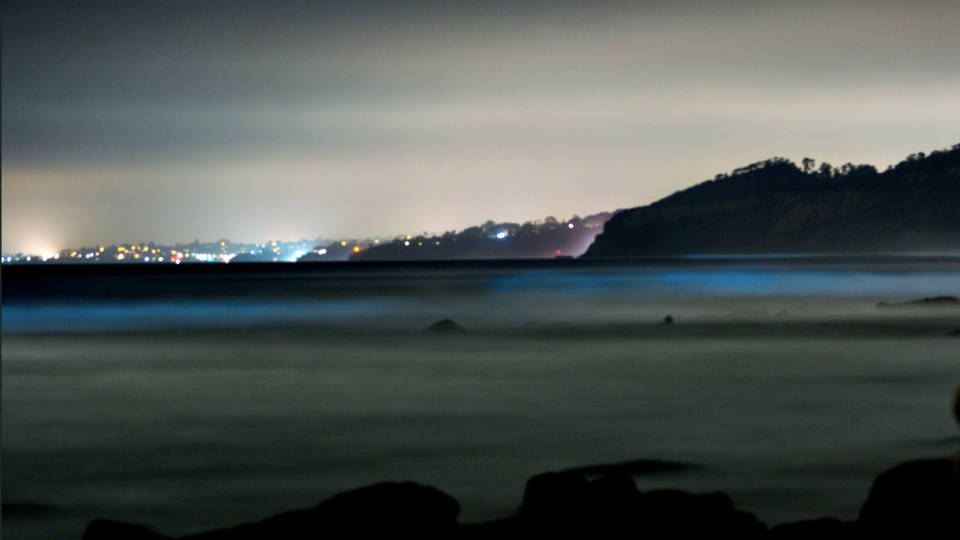Mesmerizing photos capture San Diego's view of bioluminescence turning the ocean aglow
An eye-catching, bright-blue glow could be seen from the beaches of San Diego at night this week.
The bright light glowing from the ocean is known as bioluminescence. The spectacular sight is the result of a red tide that developed off the coast of San Diego over the past few days, according to the Scripps Institution of Oceanography.
The red tide is due to aggregations of dinoflagellates, possibly because of nutrients or hydrographic conditions in the ocean. However, the cause is not entirely understood, according to Scripps Insitution of Oceanography.
Dinoflagellates may be planktonic, or may live within another organism. Ninety percent of all dinoflagellates are marine plankton. "Blooms" of dinoflagellates produce red tides, which injure marine life, according to the University of California Museum of Paleontology Berkeley.
The red tide includes dinoflagellates, such as Ceratium falcatiforme and Lingulodinium polyedra.
Lingulodinium polyedra is well known for its bioluminescent displays. The waves or movement of the water cause the phytoplankton to glow neon blue at night, according to Bioluminescence Expert Michael Latz, a scientist at Scripps Institution of Oceanography at University of California San Diego.
Red tides are unpredictable and not all of them produce bioluminescence.
Scientists do not know how long the current red tide will last. Previous events have lasted anywhere from one week to a month or more.
Bioluminescent displays are viewed best from a dark beach at least two hours after sunset, but visibility is not guaranteed.
On Monday, May 7, bright bioluminescence was observed from La Jolla to Encinitas in California.
The same spectacle was seen on San Luis Obispo County beaches last year.
Photographers and spectators are flocking to the beaches to capture this awe-inspiring natural phenomenon.
Do you have pictures of the beautiful bioluminescence that happened in the San Diego ocean last night? Send them over here to get your picture featured on #NBC7 https://t.co/f9nZxvva0f pic.twitter.com/N9jI0DQJCO
— Danielle Radin (@danielleradin) May 9, 2018
Bioluminescent waves! Last night was quite the light show in San Diego! #redtide #bioluminescence #SanDiego @UCSanDiego @NatGeoExplorers https://t.co/CqFOYCLkd4 pic.twitter.com/SqhzTOnVtz
— Antonella Wilby (@antonellawilby) May 9, 2018
This is what the #bioluminescence looked like tonight at Torrey Pines State Beach. #SanDiego #sciencerocks pic.twitter.com/kqEUySf4t6
— Melinda Bourg (@ShutterBourg) May 10, 2018
This is so beautiful!!💙#SanDiego #Bioluminescence pic.twitter.com/eSfU19Ig21
— Tapobeeva⁉️ (@iamtapo) May 10, 2018
A red tide offshore San Diego is bringing a spectacular display of #bioluminescence to beaches at night, as captured in this photo by John H. Moore. Scripps scientist Michael Latz said the red tide is due to massive numbers of dinoflagellates including Lingulodinium polyedra. 🌊 pic.twitter.com/JnSlXGBuEs
— Scripps Oceanography (@Scripps_Ocean) May 8, 2018
So excited to find some #Bioluminescence in #SanDiego last night! I couldn't resist editing this right when I got home!
A7RII - @Sigma_Photo 24-70 f2.8 @Dell XPS15https://t.co/GR4srTEkZf pic.twitter.com/4smbDLHpPz— Jack Fusco (@jwfusco) May 9, 2018
My favorite thing in the world happened last night in San Diego. Bioluminescence ✨🌙 https://t.co/wVKOi5fSWl @Scripps_Ocean 📸John Moore pic.twitter.com/tpoJrxgqPb
— Kate Furby (@seakaterun) May 8, 2018
A post shared by Ev Yorobe (@evgenyyorobephotography) on May 9, 2018 at 8:32am PDT
A post shared by C&W photography 📸 (@cwvisions) on May 9, 2018 at 7:21pm PDT


